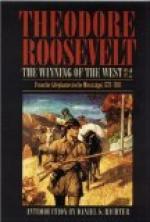These little communities were extremely independent in feeling, not only of the Federal Government, but of their parent States, and even of one another. They had won their positions by their own courage and hardihood; very few State troops and hardly a Continental soldier had appeared west of the Alleghanies. They had heartily sympathized with their several mother colonies when they became the United States, and had manfully played their part in the Revolutionary war. Moreover they were united among themselves by ties of good-will and of services mutually rendered. Kentucky, for instance, had been succored more than once by troops raised among the Watauga Carolinians or the Holston Virginians, and in her turn she had sent needed supplies to the Cumberland. But when the strain of the war was over the separatist spirit asserted itself very strongly. The groups of western settlements not only looked on the Union itself very coldly, but they were also more or less actively hostile to their parent States, and regarded even one another as foreign communities; [Footnote: See in Gardoqui MSS. the letters of George Rogers Clark to Gardoqui, March 15, 1788; and of John Sevier to Gardoqui, September 12, 1788; and in the Robertson MS. the letter of Robertson to McGillivray, August 3, 1788. It is necessary to allude to the feeling here; but the separatist and disunion movements did not gather full force until later, and are properly to be considered in connection with post-revolutionary events.] they considered the Confederation as being literally only a lax league of friendship.
Character of the Pioneer Population.
Up to the close of the Revolutionary contest the settlers who were building homes and States beyond the Alleghanies formed a homogeneous backwoods population. The wood-choppers, game hunters, and Indian fighters, who dressed and lived alike, were the typical pioneers. They were a shifting people. In every settlement the tide ebbed and flowed. Some of the new-comers would be beaten in the hard struggle for existence, and would drift back to whence they had come. Of those who succeeded some would take root in the land, and others would move still farther into the wilderness. Thus each generation rolled westward, leaving its children at the point where the wave stopped no less than at that where it started. The descendants of the victors of King’s Mountain are as likely to be found in the Rockies as in the Alleghanies.




